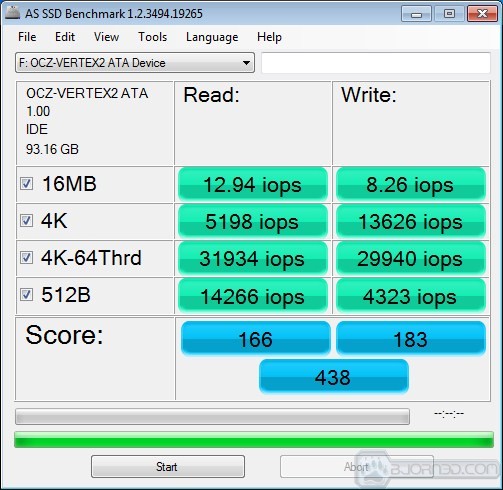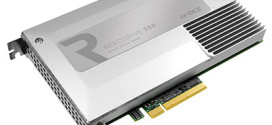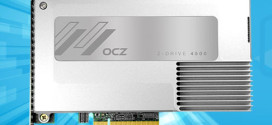Silicon Power Velox V30 60GB SSD is a nice budget SSD. We put it against top performers like the OCZ Vertex 3 to see how well it does.
Introduction
Despite using the same controller, not all SSD’s will perform the same. Besides the controller, what dictates the performance of the SSD are the type of the NAND used and the firmware. For an SSD, the controller and the NAND determine the raw performance. The firmware often will allow a manufacturer to tweak the drive’s performance in order to reach a higher transfer speed or IOPS despite the same hardware.
We have previously reviewed 240GB SSDs based on the latest SandForce 2000 controller such as OCZ Vertex 3 and Kingston HyperX. While these drives offer excellent performance, they can be relatively expensive at $200 a pop. Not everyone can afford such an expensive drive. For those who still want the performance benefit of an SSD, choosing a cheaper drive at smaller capacity is certainly an option for your primary drive. Today, we are going to take a look at a 60GB Silicon Power Velox V30 series mainstream/budget SSD based on the same SandForce SF 2000 controller.
Silicon Image Velox V30
![]()
We cannot find the retail price of the 60GB Velox drive but we would assume that it will be retailed comparable to other SandForce based SSDs like the OCZ Vertex 3 or Agility 3 at price slightly above $100. The retail drive is shipped in a very attractive retail packaging. The see-through front lets users see the drive while browsing through the retail aisles. The back has some marketing information detailing the drive’s specification of 550 MB/s maximum read and 500 MB/s maximum write speed.
The drive also supports SandForce DuraWrite technology, TRIM command, and garbage collection technology. Here we can also see that Silicon Power warrants the drive for 3 years.
Inside, we see Silicon Power includes a very handy 3.5’’ adapter bracket to install the V30 into a desktop PC without the 2.5’’ drive bay.
![]()
The Velox V30 line up includes SSDs with storage capacities from 60GB to 480GB. Our 60GB has a rated maximum 4K random write of 80,000 IOPS and sequential read up to 550MB/s and sequential write up to 500MB/s.
As with other SandForce 2200 drives, the Velox V30 supports the SATA 6Gbps interface which is backward compatible to SATA 3Gbps interface.
Features and Specification:
- Capacity: 60GB/120GB/240GB/480GB
- Dimensions: 100mm x 69.85mm x 9.4mm
- Weight: 70g
- Complimentary 3.5″ Adapter Bracket
- Vibration Resistance Test: 20G
- Shock Resistance Test: 1500G Max
- DuraWrite and wear leveling, which extends the endurance of MLC memory providing at least 5 year lifecycles with 3-5K cycle MLC flash;
- Implementation of ECC (Error Checking & Correction) technology then ensures reliability of data transmission; and
- Built-in SMART (Self-Monitoring, Analysis & Reporting Technology) enables consumers to check on the product’s operating status at any time.
What makes a 60GB Budget SSD
As we eluded, SSD performance is dependent on the controller and the NAND. Given that the 60GB Velox uses the same SandForce SF 2000 controller as the more expensive OCZ Vertex 3 and Kingston HyperX, we know that its controller has the ability offer the same level of performance as its more powerful siblings, at least at the controller level.
What about the type of NAND that is used? The Velox 60GB uses eight 25nm Intel 29F64G08ACME2 NAND devices. This is 8GB per NAND with 8-byte bus interface in single die per package. This is the same type of memory used inside the OCZ Vertex 3 120GB, but the OCZ Vertex 3 needs 16 NAND devices in order to achieve the 120GB. As we can see from the image above, the Velox V30’s eight NAND devices are on one side of the PCB and the SandForce controller is located on the reverse side of the PCB board.
Despite the same type of memory used, we should not expect our 60GB Velox V30 to perform on the same level as the Vertex 3. The SandForce SF-2200 controller has 8 channels for NAND to access. The Velox V30 has one NAND device per channel while the Vertex 3 has two NAND devices per channel. The latter configuration allows the data to be interleaved and there is a potential performance benefit when paired up with the proper controller.
The SandForce 2200 controller gives the drive manufacturer the option to disable RAISE. RAISE, or Redundant Array of Independent Silicon Elements, is SandForce’s way of ensuring data redundancy to prevent data loss in the event a single NAND chip dies. In order to provide redundancy, a single die of NAND storage space is required.
SandForce allows drive manufacturer to disable RAISE, leaving the new 55-bit BCH EDD engine for any error correction. The Silicon Power Velox V30 has RAISE enabled disabled. Since the Velox V30 that uses 8GB 25nm NAND, this can mean 8GB of space is not user accessible for overprovision. So while the eight 8GB NAND devices are found on the drive, which works out to be a total of 64GB storage, Silicon Power only advertises the drive to be a 60GB drive. In fact, if we did our math, there is technically only 56GB of free storage space available when we discount 8GB of NAND for redundancy and in Windows we see it is formatted as a 51 GB drive.
SandForce SF-2200 SSD Bug?
When we reviewed the OCZ Vertex 3 drive, we encountered an odd issue during testing period of the drive. When we used the drive with SATA 3 Gbps, we experienced random lock ups and BSOD crashes. The drive would randomly disconnect itself when in operation. We contacted OCZ and were informed that we should enable hot-plugging in the BIOS on the SATA II ports. The problem went away immediately once we enabled hot-plugging.
A glance at OCZ’s firmware forum shows a thread with extensive posts regarding the firmware issue that causes the BSOD. It appears that many people with GIGABYTE boards have similar issues but the problem is not limited to GIGABYTE boards. So far, we do not yet know if this is a specific issue with the motherboard or the firmware on the drive. While we encountered the issue with the OCZ Vertex 3 drive, it appears that other SSDs based on the new SandForce controller also suffered from the random drive disconnect issue.
Since the Velox V30 also uses SandForce controller, it potentially may have the similar problem as with other SF drives. However, we are happy to report that during our testing period, we did not encounter any problem. We actually tested the drive with a GIGABYTE Z68 board as well, so it may be that the issue is related to the firmware on the SSD rather than the motherboard’s BIOS.
We will stay on top of the issue and reports any new findings that we uncover.
TESTING & METHODOLOGY
To test the Silicon Power Velox V30 we cloned our test rig drive to the SSD. It is the same test drive we’ve been using on all of our drive testing and is nothing more than a clean Windows load with all the drive testing software installed, as well as all the current drivers and patches for the OS. It’s the equivalent of doing a fresh load of Vista from the disc but takes a lot less time and ensures that every drive tested uses exactly the same OS load and drivers. Nothing that may effect the outcome of the testing procedure can creep in. We ran all of the tests a total of 3 times and averaged those results. The Average of the three results are presented here. In the case of a pictorial benchmark we ran the bench 3 times and picked the median result. As with most SSD testing differences from run to run are minimal and the median result is a good indication of what you can expect from the drive.
We ran our usual battery of tests on the drive, and used it as the primary boot drive during testing. All of the drives tested were used as the primary boot drive during testing. That’s a more realistic test than strapping the drive in and testing it with a bare format or as a non-boot drive and it represents real life transfer rates, much like you can expect when you install and operate the drive in your own system. Each test was performed 3 times and the average of the 3 test run is reported here.
Test Setup
| Test Setup | |
| Case Type | None |
| CPU | Intel Core i5 2500K |
| Motherboard | Asus P8Z68-V Pro |
| Ram | Kingstone HyperX 1600 |
| CPU Cooler | Prolimatech Megahalem |
| Storage Drives | Silicon Power Velox V30 60GB OCZ Vertex 3 240GB OCZ RevoDrive 80GB OCZ Solid 2 60GB Kingston SSDNow V+ 128GB MLC OCZ Agility EX 60GB (SLC) Kingston SSDNow V 40GB (MLC) Kingston SSDNow V+ 128GB (MLC) G.Skill Titan 256 GB SSD (FM-25S2S-256GBT1) (MLC) Patriot 128GB Warp SSD (MLC) Intel 80 GB SSD X25-M G.Skill 64GB SSD (FM-25S25-64GB) (MLC) 2 WD VelociRaptor’s 300GB (In single and RAID 0) WD 160 GB SATA 2 Maxtor 160 GB SATA 2 WD & Maxtor in RAID 0 |
| Optical | None |
| GPU | Gigabyte GTX 260 OC |
| Case Fans | 120mm Fan cooling the mosfet CPU area |
| Docking Stations | None |
| Testing PSU | Cooler Master UCP 900W |
| Legacy | None |
| Mouse | Microsoft Intellimouse |
| Keyboard | Logitech Keyboard |
| Gaming Ear Buds | None |
| Speakers | None |
Test Suite
| Benchmarks |
| ATTO |
| CrystalDiskMark |
| AS SSD Benchmark |
| PCMark Vantage |
| PCMark 07 |
ATTO
Storage manufacturers often use ATTO to rate their drives. ATTO is designed primarily for mechanical drives, not for the SSDs. While it may not always tell the whole story, we include it just to give an idea on how the SSD stacks up against other drives. Also, it is worth re-testing to confirm the veracity of the manufacturer’s claim.
The drive performs better at 1024K, achieving 550 MB/s write speed.
We included a shot of the ATTO screen to show the drive’s performance. As we can see the drive hits the theoretical transfer rate at 256KB transfer size.
CrystalDisKMark
4K
And the 4K write is rather impressive and it takes the top stop, edging out the Vertex 3.
However, at higher queue depth, the drive suffered due to lack of interleaving support. Here we can see that the drive is about 1/4 of the performance in read and 1/3 of the performance in write compared to the Vertex 3. However, if we compare to the older SandForce drive, it is about 1/2 of the throughput offered by the SandForce SF-1000 drives (Vertex 2 and RevoDrive).
Notice that, however, that the Velox V30 is faster than the Kingston SSDNow V100, so despite the fact that it cannot compete against the more expensive drives, it is still quite competitive.
512K
However, 512K write speed for the drive suffered. We can see that the Velox V30 is faster than Solid 2 but is slower than the Kingston SSDNow V+.
Sequential
The sequential write is rather slow for the drive. We can see that the Velox is slower than a few mechanical drives. Obviously, this drive is not going to be a primary drive for those who transfer large amounts of data.
AS SSD Benchmark
4K
AS SSD tests the drive’s ability at handling incompressible data and like many other SandForce drives that feature real-time compression, the Velox V30 performs right where we expect it to be. SandForce’s weakest spot has always been it’s lower performance at incompressible data as its DuraWrite technology cannot compress data any further.
When comes to write, the drive is faster than Vertex 2 and Kingstons SSDNow V100 but lags behind the Vertex 3.
4K-64K Thread
Sequential
As expected, the drive’s sequential read is decent but the sequential write suffered.
IOPS
Velox V30 60GB
OCZ Vertex 3 240 GB
The performance of an SSD is not always dependent on raw transfer speeds (MB/s). A drive with higher number of Input/Output Operations Per Second (IOPS) often performs better despite a lower MB/s. Here we can also see the Velox V30 hits 31K read and 30K write IOPS for the 4K-64 thread. The drive is no where close to the 80,000 IOPS that the drive’s specification states.
Comparing the IOPS to the Vertex 3, we can see the biggest difference in the IOPS between the two drives is the 16MB file size where the Velox V30 has about 1/2 of the IOPS as the Vertex 3. The drive does has slightly better 4K read IOPS for single queue transfer. At 4K 64 thread, it is about 60% of the performance of the Vertex 3.
PC MARK 7
PCMark Vantage is a bit old and can sometimes over-exaggerate the drive’s performance so we also include the latest version of PCMark test suite that has more realistic assessment of a drive’s performance.
If we use PCMark 07 as our sole performance assessment, we can see the Silicon Power V30 is rather good as it performs at the same level as the Vertex 3 240GB using SATA III. It is also faster than the OCZ Solid 2 and the Kingston SSDNow V100. This same result is what we will see throughout most of the PCMark 07 benchmark tests with exception of a few.
Importing pictures stresses the drive’s read performance and we can see that the Velox V30 60GB performs like the other 60GB drive, OCZ Solid 2 here.
Video editing involves sequential read and write of incompressible data and the V30 is just a tad behind the Vertex 3 but is faster than the RevoDrive here.
Application load tests the drive’s random read performance. Notice that the V30 is about as fast as the Vertex 3 using SATA 2 port.
Conclusion
We know that going with a smaller size SSD not only sacrifices capacity, but also potentially performance due to the type of NAND used. We were not sure how much of performance difference would it be and this is where the Silicon Image Velox V30 can help to shine some light.
Comparing the performance of the 60GB Velox V30 to the 240GB Vertex 3, we can see that that the smaller drive can keep up with the larger drive in random read and write with small queue depth. However, it cannot keep up with larger current drives (or even last generation performance drives like the Vertex 2).
The drive has a good sequential read. While it is not as fast as the Vertex 3, it is faster than any SATA II drives on the market. However, its sequential write is not as impressive, and even some mechanical hard drives are faster.
Ultimately, for a 60GB drive, the Velox V30 is certainly a nice budget system drive. The fast read performance on the drive will make a system run snappier and applications boot up faster. Unless users are creating a lot of large files like HD videos, the slower write speed on the drive should not be overly noticeable. For a budget drive that offers support for TRIM, garbage collection, and 3 year warranty, the Velox V30 is actually a pretty good choice for a $100 SSD.
| OUR VERDICT: Silicon Power Velox V30 60GB | ||||||||||||||||||
|
||||||||||||||||||
| Summary: The Silicon Power V30 60GB is a good choice for those who are looking to boost their system performance. For its value and quality, it earns the Bjorn3D Seal of Approval. |
 Bjorn3D.com Bjorn3d.com – Satisfying Your Daily Tech Cravings Since 1996
Bjorn3D.com Bjorn3d.com – Satisfying Your Daily Tech Cravings Since 1996







